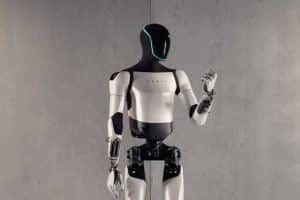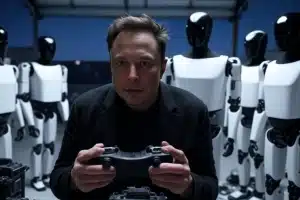- 🚀 Tesla plans to rent out its Optimus humanoid robots before starting sales.
- 🏭 Multiple Optimus robots are already performing tasks at Tesla’s Fremont factory.
- 🕰️ Tesla aims to start selling the Optimus robot by next year.
- 🛠️ Upcoming improvements will give Optimus 22 degrees of freedom in its hands.
- 👣 Recent updates show Optimus can now perform tasks autonomously with improved walking speed.
- 🧠 Optimus robots are mostly used for sorting battery cells and placing them in shipping containers.
- 🎥 Elon Musk has been sharing monthly updates on the Optimus program.
- 💡 The rental program details and potential renters have not been disclosed yet.
As we edge closer to a future dominated by artificial intelligence and automation, Tesla continues to be at the forefront of technological innovation. The Optimus humanoid robots, designed to transcend human limitations and bring about unprecedented efficiency, are Tesla’s latest audacious venture. Today, we delve into Tesla’s plans for these groundbreaking machines, including an exciting rental option ahead of full-scale sales, and what these developments mean for industries worldwide.
Tesla, under the visionary leadership of Elon Musk, has been a pioneer in electric vehicles and renewable energy solutions. Now, the company is setting its sights on revolutionizing the field of robotics with its Optimus humanoid robots. As Tesla gears up to launch this transformative technology, intriguing details about a rental program and autonomous capabilities beckon discussion.
Overview of Tesla’s Optimus Robot
The Optimus humanoid robot has been in development for the past few years, with Tesla providing consistent monthly updates on its progress. These robots boast impressive capabilities designed to mimic human physicality, making them suitable for a wide array of tasks that require dexterity and precision.
Rental vs. Sales: Strategic Insights
Rental Program Launch
Elon Musk recently revealed that, before the general sales of Optimus robots commence, Tesla will offer a rental option. This strategic move allows companies to integrate advanced robotic solutions without the initial capital expenditure, thereby lowering the barrier to entry.
Benefits of Renting
- Cost Efficiency: Companies can assess the value Optimus robots bring to their operations without the significant upfront costs.
- Flexibility: Renting provides flexibility in scaling robotic deployment up or down based on business needs.
- Trial Period: A rental option serves as a trial period, offering hands-on experience and aiding in decision-making regarding future purchases.
Current Applications in Tesla’s Factories
Factory Integration
Already, multiple Optimus robots are operational within Tesla’s Fremont factory. Primarily, these robots assist in:
- Sorting Battery Cells: Optimus sorts battery cells, enhancing efficiency and reducing operator fatigue.
- Packaging: The robots place sorted cells into shipping containers, streamlining the logistics process.
Real-World Performance
Elon Musk shared insights during Tesla’s 2024 stockholder meeting, indicating that the current robotic workforce will expand to over a thousand units by next year. The implications for productivity and operational efficiency are profound.
Technological Advancements and Future Improvements
Degrees of Freedom
A notable upcoming enhancement is increasing the robot’s hand degrees of freedom from 11 to 22. This improvement is expected later this year and will significantly bolster the robot’s fine motor skills, aligning them closer to human capabilities.
Autonomous Functionality
Recent video demonstrations have showcased Optimus performing tasks autonomously, with notable improvements in walking speed and stability. These advancements highlight the robot’s potential for independent operation in complex environments.
Continuous Updates
With monthly updates, Elon Musk ensures transparency and keeps stakeholders informed about progress. This consistent communication is vital for gauging future possibilities and preparing industries for robotic integration.
Industry Impact and Expectations
Transforming Industries
The introduction of rental Optimus robots is poised to change how industries approach automation. The potential applications span several sectors, including:
- Manufacturing: Streamlining production lines and enhancing precision in assembly tasks.
- Logistics: Improving supply chain efficiency through autonomous sorting and packaging.
- Healthcare: Assisting in routine tasks, patient care, and medical logistics.
- Retail: Enhancing customer service and inventory management.
Future Outlook
By next year, the sale of Optimus robots is expected to commence, creating a paradigm shift in workforce dynamics. Companies across industries should prepare for this revolution through early adoption via the rental program and strategize for long-term integration.
Conclusion
Tesla’s Optimus humanoid robots stand as a testament to the advancements in robotics and AI, heralding a new era of automation. The offering of a rental option before full-scale sales is a strategic masterstroke by Tesla, ensuring that these robots reach a broader audience. As we step into this future, industries worldwide must embrace and adapt to these innovations, fostering a symbiotic relationship between humans and robots for unparalleled growth and efficiency.
In essence, Tesla’s Optimus is more than just a robot; it represents the future of human-machine collaboration—bringing us closer to a world where possibilities are endless and efficiency knows no bounds.





